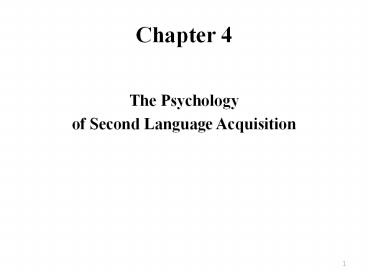The Psychology - PowerPoint PPT Presentation
1 / 13
Title: The Psychology
1
Chapter 4
- The Psychology
- of Second Language Acquisition
2
Languages and the brain(areas involved in
language activity)
- Paul Pierre Broca (1861, 1865) Brocas area
- Wernicke (1874) Wernickes area
- Sylvian fissure lateral sulcus lateral
fissure - a cleavage that separates lobes in the brain
- (one of the most prominent structures of the
human brain)
3
Core linguistic functions for sign languages used
in deaf communities are also located in the left
hemisphere.
4.1 Principal communicative specializations of L and R hemisphere
Principal hemispheric specializations
Left hemisphere Right hemisphere
Phonology Nonverbal (as babies cries)
Morphology Visuospatial information
Syntax Intonation
Function words and inflections Nonliteral meaning and ambiguity
Tone systems Many pragmatic abilities
Much lexical knowledge Some lexical knowlege
4
1. How independent are the languages of
multiligual speakers?
- Ervin and Osgood (1954 following Weinreich 1953)
- three way possibility for how languages
relate - in an
individuals mind - a. coordinate bilingualism parallel
linguistic systems -
no ablity to translate between them - b. compound bilingualism fused or unified
sytem - c. subordinate bilingualism one linguistic
system accessed -
through another - Obler and Gjerlow (1999, 140)
- stress the interdependence of
languages
5
1. How independent are the languages of
multiligual speakers?
- Ervin and Osgood (1954 following Weinreich 1953)
- three way possibility for how languages
relate - in an
individuals mind - a. coordinate bilingualism parallel
linguistic systems -
no ablity to translate between them - b. compound bilingualism fused or unified
sytem - c. subordinate bilingualism one linguistic
system accessed -
through another - Obler and Gjerlow (1999, 140)
- stress the interdependence of
languages
6
2. How are multiple language structures organized
in relation to one another in the brain? Are
both languages stored in the same areas?
- 3. Does the organization of the brain for L2 in
relation to L1 differ with age of acquisiton, how
it is learned, or level of proficiency? - ans probably yes
- Vaid (1983) concludes that individuals who
acquire L2 later in life show more
right-hemisphere involvement. - Wuillemin Richards (1994) more
right-hemisphere involvement for L2 acquisition
between the ages 9 and 12 than for those who
acquire L2 before age 4.
7
4. Do two or more languages show the same sort of
loss or disruption after brain damage?When there
is differential impairment or recovery, which
language recovers first?
- Same or very similar patterns of loss and
recovery for both/all of most multilingual
persons languages, but may exceptions have been
reported. - We may conclude that what is being added in the
brain when a second language is acquired is not
very different from, nor usually entirely
separate from, what is already there for the
first.
8
Learning Processes
- Information Processing (IP) John Anderson (1976,
1983) - Learning language is essentially
like leaning other domains - of knowledge.
- Connectionism learning is learning, but
- considers learning processes as a
matter of increasing - strength of assoiations rather
than as the abstraction of - rules or principles
9
Three stages of Information Processing
(Skehan, 1998)
- Research that measures the amount of time it
takes multilinguals to call words and grammatical
structures shows that the L2 of even fluent
speakers of both languages is generally less
automatized than their L1, and less proficient L2
is less automatized than more fluent L2. - U-shaped development correct form?incorrect
form?correct form - feet ?
foots ? feet
Input Central processing Output
Perception Controlled-to-automatic processing Production
Declarative-procedural knowledge
Restructuring
10
Theories regarding order of acquisition
- Multidimensional Model
- Clahsen (1984, 221)
- linguistic structures which require
a high degree of - processing capacity will be
acquired late - hierarchy (1) Canonical Order Strategy
- (2) Initialization/Finali
zation Strategy - (3) Subordinate Clause
Strategy - Processability Theory (Pienemann 1998)
- processing and explaining the
sequences in which processing - skills develop in relation to
language learning
11
Acquisitional hierarchy of processing skills
(Pienemann
Häkansson, 1999)
- Lemma/word access
- Category procedure
- Phrasal procedure
- S-procedure
- Clause boundary
12
Competition Model
- Bates MacWhinney (1981), MacWhinney (2001)
- Learning the system of
form-function mapping is basic for L1
acquisition. SLA involves adjusting the
internalized system of mapping that exists in the
learners L1 to one that is appropriate for the
target language. - MacWhinney (2001, 74-75)
- - Task frequency
- - Contrastive availability
- - Conflict reliability
13
Connectionist approaches
- Parallel Distributed Processing (PDP)
- Processing takes place in a network of
nodes (units) in the brain that are connected by
pathways. - As learners are exposed to repeated
patterns of units in input, they extract
regularities in the patterns probabilistic
assoications are formed and strengthend.

